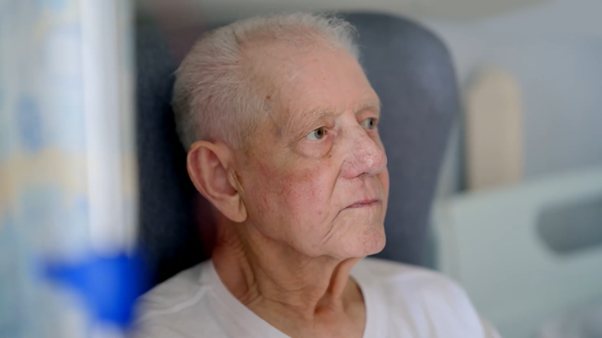79-year-old retired security guard John is at the Freeman Hospital for a complex aneurysm repair.
Six weeks earlier John had an accident in the street on his way to his favourite pub. “I was going out to the pub and it was only 5.50pm and I tripped on this kerb and fell flat on my face. About a fortnight later I got off the bus and I thought a I’ll have a look again to see if there’s a raised kerb or anything like that and as I was looking I fell over the kerb next to it – in the same place – it was about 5.55pm this time and I couldn’t believe it!” John explains.
After his fall John’s daughter took him to hospital where scans revealed a more serious issue. John had a major swelling in his main artery – called an aneurysm – which could rupture at any time.
Performing John’s surgery is endovascular surgeon Craig Nesbitt – the surgery is life saving and could prevent his aneurism from rupturing.
The surgery will involve diverting blood through John’s aneurysm using waterproof mesh tubes call stents. Craig explains: “The stent is introduced into the groin under x-ray guidance until it’s in place and as we pull back the graft starts to open up inside the patient until its fully deployed, the device comes out and the stent graft is left behind.”
John needs three stents above and below the graft. The aneurysm remains but by diverting the blood it no longer becomes at risk of rupture.
Craig comes to speak to John before his surgery – it’s a risky procedure and however if the aneurysm remains there’s a very real risk it could rupture. “Well take good care of you John – we can’t make promises, but I promise we’ll take good care of you.”
In theatre 9, Craig is working alongside radiologist Pete and begins the complex keyhole surgery to insert the stents.
They use a small hole in John’s groin to navigate to wherever they need to. Craig creates as small amount of cuts as possible to hopefully help speed up John’s recovery.
Craig inserts metal wires into John’s arteries so the can see them on the x-ray and guide the stents in place. Without the x-ray they’re blind.
To help them to see where they are going they have to inject a dye into John’s blood stream “That essentially gives us a road map so that we can see where were going.” Explains Craig.
A major concern for John is that he’s had poor kidneys for some time and unfortunately the dye can irritate the kidneys. Using the correct amount of dye – or contrast – is going to be crucial so as not to cause irreversible damage.
The first stent is placed and the top of the aneurysm and must be placed in the perfect position – 1mm the wrong way and it could be a catastrophe.
Once the first stent is in place is time to place the second one – which needs to be exactly the right length and in exactly the right place to connect to the first.
This is a risky procedure for a patient as frail as John, so every stage has to be precise.
With all three stents in place, Craig now needs to seal the joins between them using balloons. To check the stents are in place Craig injects more dye into John’s blood stream. The contrast needs to run through the graft and not into the aneurysm. After a check…. “It’s all landing exactly where we want it to.”
“The point where you do your final run and you can see that your aneurysm is excluded and the stent graft is sitting nicely you can say things have gone to plan and that’s a good moment” says Craig. Now it’s time for John to go to recovery!
After a short stay at the Freeman John is now back home and recovering well. He hopes to visit the pub soon but will take a new route.
